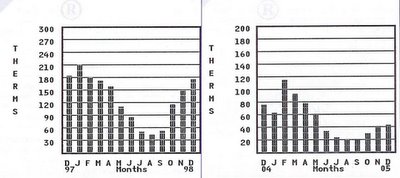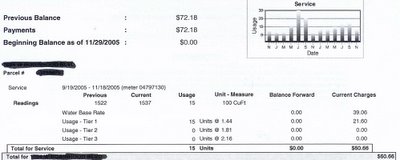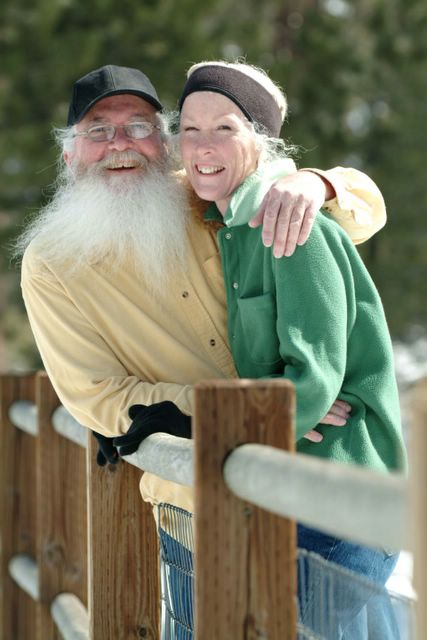A Toast To Norene's Five Percent!
During that period of time we swore off owning an automobile (January 31st, 1997) which we were driving about 12,000 miles per year. A modern vehicle that gets 20mpg spews about a pound of carbon dioxide per mile, so, by my reckoning, we've personally eliminated close to 100,000 pounds from the atmosphere in the past 9 years (This isn't something everyone can do, but in our situation it was feasible to try it, and we're very happy with our decision). You'll notice that driving 12,000 miles per year for 9 years should add up to 108,000 pounds of CO2, but I think we have driven maybe a total 6,000 to 8,000 miles since 1997 in rented or borrowed cars.
I know we drove about 3,000 miles, this past few months alone, going to the hospital to visit our son and taking him to doctor appointments. We rented a car for that purpose until our neighbor Cheri said we could use hers whenever we needed. But that's mostly behind us at this point.
About 1993 we made a list of all the electric appliances we could do without, the micro-wave, the food processor, the blender, the coffee maker etc., and then when our refrigerator, washer & dryer died we replaced them with the most energy efficient ones we could afford, and about that time we changed every light bulb in the house to a compact flourescent (an article I read recently cited a study which concluded that if everyone in California switched all their bulbs to flourescent our population could double before we'd need to build another power plant---I sure don't want to see the population double---but that was a revelation).
In 2002 we heavily insulated the roof (about R39 total) and the floor of our cabin, installed dual-pane low-e glass windows & doors, and a couple of years earlier we had replaced our water guzzling lawn with drought-tolerant plants & flowers native to this area.
In any given year none of these projects required 5% of our energy (well maybe the roof did, a friend & I spent two solid weeks up there, and the cost was about $3,500 total) but the resulting savings in resource consumption and utility costs are compounding quite rapidly. The State of California also gave us about a 25% rebate on the cost of the doors, windows and insulation.
But there is always more to be done and I see that we've slacked off a bit in our focus & commitment (it was a tough year for us), so here's to Norene for the wake-up call. I wonder how much could be accomplished if I were just 5% more thoughtful each day.
Here are some comparisons of our historical use of gas, water and electricity with our current usage.
Natural Gas
Below you will see two graphs scanned from previous gas bills, at the left is the December 1998 bill, and, on the right, December 2005. Don't go by the height of the columns, because the scale is adjusted to ones usage, look at the actual numbers on the left for therms used. This December we used just over 40 therms of gas as compared to about 75 last December, a 47% reduction, and we used over 180 therms for the same month of 1997, which means a reduction of 78% from 8 years ago (Not bad considering our elevation of 6,750 ft. in heavy snow country, and we're still improving).

Click on photo to enlarge
Electricity
Our most recent electric bill shows that we used 528 KWH for the 2 month period of October & November, or 8 KWH per day, a 31% increase over the previous year, which means we've been backsliding on our conservation efforts this year (too much blogging maybe), but I dug out an old electricity bill to compare with our current bill and found that for the same 2 month period in 1996 we used 929 KWH or 14.3 KWH per day, so even if we slipped a bit we're still conserving 44% more electricity than in 1996. And we're 71% below the national average of 28 KWH per day, but we can do better.

Click on photo to enlarge
Water
We don't have an older water bill to compare our current usage with but I called the Community Services District and asked if they kept historical records of usage and they told me that our record usage was 59 units for 2 summer months back in the days when we had lawn here instead of the native plant garden. Because we grow vegetables our usage still increases in summer, but our rain barrel storage and careful monitoring have this past summer resulted in a peak usage of about 20 units, a 66% reduction from our highest consumption rate several years ago.

Click on photo to enlarge
Labels: automobiles, conservation, energy efficiency, environmentalism, lists and charts


11 Comments:
I like your numbers, Jim!
Up here in winter, I have strangling eco-guilt because the furnace is always kicking on, it's very dark, so the lights are on, etc.
I'm looking forward to getting our rain-barrels operational this spring, too, ; we got them second hand from a 90 year old farmer who's working his 10 acres very intensively, which was a delight to see in the middle of the industrial heartland. And Chive and I have started the "box-talks" - it's time to get those grow-boxes planned and WHERE am I going to get the dirt to fill them? Ah, come, lovely spring!
Congrats! Good job walkin' the walk.
I'm glad the 5% concept has lit a little spark for you. It's so simple, and as your post shows, no matter where we are in life, what we have already accomplished, there's always room for another 5%.
When I look at the 5% concept baseline, I first subtract that standard 8 hours a day for sleep, as an average. 5% of the remaining 16 hours a day comes out to 48 minutes. If you look at the energy and time you put into improving your chicken coop, garden, insulation, researching and buying energy-saving appliances like your washer and dryer, thinking about getting rid of your coffee maker and blender and then actually doing it, walking or driving your bike instead of driving, tracking your energy savings on a spreadsheet, thinking about what else you could do and would like to do to make a difference, I think you personally come out to 5% easily. I'd say you're way over 5%.
You said:
I wonder how much could be accomplished if I were just 5% more thoughtful each day.
and that 5% improvement idea is what creates the lovely compounding effect that you mentioned on my blog. If you were someone who maybe had some fleeting moment of guilt when throwing the broken TV in the trash can, 5% improvement would be measured in teeny tiny bits. But you are someone who is already doing so much more that your 5% more anything--thoughtfulness or direct action--is a large and welcome weight on the scale.
Jim, where did you get the statistic that the national average electric consumlption is 28 KWH per day. I'd like to read more and perhaps link to the source if possible.
Thanks.
Mum-
For most of the years we lived in this cabin our heat just went through the roof and the windows but we were finally able to remedy most of that a few years ago. Still, we've always supplemented our gas heat with wood which is plentiful and relatively cheap here, but not the cleanest fuel for sure. But our wood stove is a highly efficient EPA emissions approved non-catalytic model, Vermont Castings Aspen 1920, that recirculates secondary air for cleaner combustion of the gases.
The small stove is designed to heat 600-1200 sq. ft. and keeps our little 950 sq. ft. very comfortable even on the coldest days, which can get down to 16 below zero (fahrenheit) on occasion.
Still, I watch all that wood go up in smoke every winter feeling guilty too, but at least by using wood heat in a place where dead wood is abundant, we're not contributing much to the need for oil & gas exploration or production in nature preserves or foreign countries, and all the infrastructure, associated costs, socially, environmentally and militarily. But it would surely be a barren smoky world if all 6 1/2 billion people heated with wood, there are just too many of us.
Walter-
Thanks, we're working on it, but there's always so much more to be done.
Janet-
Thanks for linking to us Peace sister. :~)
I'll get back to you on the books.
Norene-
Sometimes I feel like we're not doing nearly as much as we could or should be, so it's very nice when someone who actually knows us in real life thinks we're accomplishing something, or at least making a bit of a difference.
And your 5% idea renders the thought of further improvement much less overwhelming, a sort of one step at a time approach.
We humans are so busy pointing the finger toward the other culprits that are causing all the problems, when the truth is, that the enemy is us, each one of us
For years I've strived to keep that finger pointed at myself more often, because after all, conservation, responsibility, community, peace and love all begin at home, and 5% a day over 365 days is 1825%.
I Wonder-
I got the 28 KWH per day average from the Carbon Use calculator from the Bonneville Environmental Foundation, which you'll find in the sidebar of Norene's 5% blog.
I simply divided the annual average of 10,388 KWH by 365.
I've seen several similar usage averages over the years and I'll e-mail you a link to the carbon calculator and another chart I found this morning showing almost the exact same national average.
I Wonder-
I see you don't have e-mail access at your blog so I'll put those links here.
Here's the one for the carbon calculator
https://www.greentagsusa.org/greentags/calculator_
step1.cfm
And the 3rd graph down at the webite below shows an almost identical usage.
http://www.ibrc.indiana.edu/iib/06152001.htm
Sentences 3 & 4 at the following link show an average California KWH costing 10.7 cents, an average residential bill of $107 per month, which would mean a monthly usage of 1,000 KWH, 12,000 KWH yearly, and about 33 KWH per day.
http://www.physics.uci.edu/~silverma/national.html
Jim, thanks for the links. My email is paul at paju.us.
I have a 1 KW solar array and a 400 W wind generator. My wife and I use about three and one-half KWH per day. We've pared things down but we live comfortable and don't deny ourselves.
I am in the process of creating a website and want to link to good sources. At present I have too many obligations and have only one part of the site functional.
in scotland one electricity company gave us 4 free low bulbs, I took them with me when I moved and because I moved and became a "new" customer they gave me 4 more, thanks to them my whole house ,including two deep storage cupboards, has these bulbs. maybe I should complain because one of them just popped after 8 years.....our local government authority gave me free cavity wall insulation(the house below me is rented out by them)when they did their own properties, and when I bought my house I had new double glazed windows installed. We are just waiting on a new roof, they are paying towards most of the costs but my neighbor and i have each to pay £2000 towards it. then I will insulate the roof space somemore- not worth doing it just now as there are 6 buckets catching the drips and things are damp! the house is much warmer than the first year I lived here.. I was so cold I spent the entire winter going back to bed to keep warm!
I'm impressed and inspired by your efforts to reduce your energy consumption, Jim. Analyzing old bills, etc. Wow!
Just a side note on the bulb issue--while it still seems to make sense to switch to flourescents (big picture), I didn't realize until I was doing some research last year that they contain mercury.
In VT, by law they have to be disposed of as hazardous waste. When they aren't, they often break at the landfills and release mercury, which enters our air and water supplies (I've got research reports related to it if you're interested). It's quite an interesting dilemma considering that coal burning power plants also release mercury, which is one incentive to reduce fossil fuel dependence and use the flourescent bulbs. Oh well, as Mika often tells me, "There are no simple answers."
Lene-
No, there are no simple answers, and I am aware of the mercury in flourescent lighting, so we dispose of them at our hazardous waste site here, but it still ends up somewhere doesn't it?
In the decade or more that we've been using compact flourescent bulbs though, I can only remember two that burned out, requiring disposal. They're supposed to last at least 7 years but I know most of ours have been in use for over 10.
Hi Jim,
Thanks for responding--and thanks for raising the important issues. :)
Lene
Post a Comment
<< Home